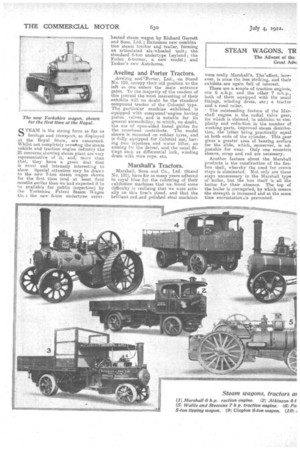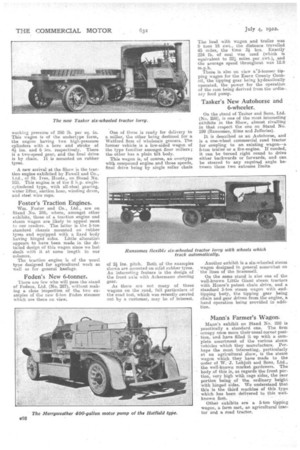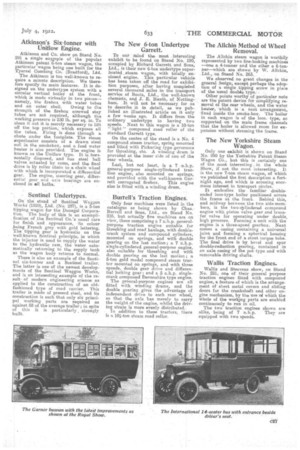STEAM WAGONS, TR D TRACTOR ENGINES.
Page 20

Page 21

Page 22

Page 23

If you've noticed an error in this article please click here to report it so we can fix it.
STEAM is the strong force so far as 1.7 haulage and transport, as displayed at the Royal Show, are concerned. Whilst not completely coveng the steam vehicle and traction engine industry the .21 concerns showing steam plant are very representative of it, and, more than that, they have a great deal that is novel and intensely interesting to show. Special attention may be drawn to the new 7-ton steam wagon shown for the first time (and at least four months earlier than we had expected it to he available for _public inspection) by the Yorkshire Patent Steam Wagon Co. ; the new 6-ton undertyoe super
heated steam wagon by Richard Garrett and Sons, Ltd. ; Rarisomes new combina tion steam tractor and trailer, forming an articulated six-wheeled unit; the standard 6-ton undertype Leyland ; the Focien 6-tonner, a new model ; and Tasker's new Autohorse.
Aveling and Porter Tractors.
Aveling and I"Porter, Ltd., on Stand No. 120, occupy their old position to the left as one enters the main entrance gates. To the majority of the readers of this journal the most interesting of their exhibits will no doubt be the standard compound tractor of the Colonial type. The particular machine exhibited is equipped with compound'engine having piston valves, and is notable for its general accessibility, to which, no doubt, the use of open-sided bored guides for the crosshead contribute. The model shown is mounted on rubber tyres, and is fully equipped for Colonial use, having two injectors and water lifter, an awning for the driver, an& the usual fittings such as differential lock, winding drum with wire rope, etc.
Marshall's Tractors.
Marshall, Sons and Co., Ltd. (Stand No. 191), have for so many years adhered to royal blue for the colouring of their exhibition machines that we found some difficulty in realizing that we were actually on this firm's stand, and that the brilliant red,and polished steel machines were really Marshall's. The'effect, however, is none the less striking, and their exhibits.are again full of interest.
There are a aouple of traction engines, one 6 n.h.p. and the other 7 n.h.p., both of them equipped with the usual fittings, winding drum, etc; a tractor and a road roller.
' The outstanding feature of the Marshall engine is the radial valve gear, for which is claimed, in addition to simplicity and reduction in the number of working parts, improved -steam distribution' the latter being practically equal at both ends of the cylinder. This gear gives a greater area of bearing surface for the slide, which, moreover, is adjustable for wear. Only one eccentric sheave, strap and rod are necessary.
Another feature about the Marshall products is the construction of the firebox shell, whereby the need for crown stays is eliminated. Not only are these stays unnecessary in the Marshall type of boiler, but the box itself is all the better for their absence. The top of the boiler is corrugated, by which means the strength is increased and at the same time encrustation k is prevented.
New Ransomes Combination,
On Ransotnes, Sims and Jeff eries Stand, No. 199, is one of the most interesting exhibits in the whole Show. It is referred to in the catalogue as a new implement, being entered for the R.A.S. silver medal this year. It is described as a lorry conversion attachment for converting a four-wheeled platform vehicle or steam wagon into a sixwheeler of greatly increased carrying capacity. It is shown fitted to a Ransome's steam wagon, and represents an entirely new departure in the sixwheeled priueiple as applied to conamercial vehicles. Instead of, as has hitherto been the rule, mounting a turntable on the rear of the motor vehicle, Ranseines nse two turntables or their equivalents, one upon the rear of the chassis and one over the rearmost of the three axles; the unit, comprising the rear axle and the framework connecting it with the tractor vehicle is very short, and is coupled to the hack of the main chassis. The bodywork extends between and beyond the two turntables. Better 'tracing of the two sets of wheels and less liability to swing or skid are claimed tor tnis arrangement.
The same firm show a rubber-tyr+3d steam tractor and a couple of traction engines.
Clayton Steam and Electric.
Clayton Wagons, Ltd., on Stand No. 196, have a 5-ton steam wagon and an electric vehicle.
The steam wag-,ort is of the unclertype mounted on rubber tyres, which are fitted to cast wheels. It is equipped with an end-tipping body, the tipping gear being of the twin-screw type operated by gearing from the engine, which gearing is easily 'controlled by means of a clutch. As an alternative, the horizontal shaft of the gear is fitted at its ends with squares, so that in case of need the gear can be operated by hand. This make of steam wagon is so well known that there is little -need for us to deal with its features in detail. It may be remembered that the latest design of wagon is notable for the care which has been taken to provide ample shelter for the driver, and at the same time to increase the driver's eye view which is afforded.
The electric vehicle is of the single motor type with one gear redaction to a differential cross-shaft, and final idrive by twin roller chains. Another exhibit on this stand is a compound steam traction engine.
Leylands Show a Steamer Only.
Leyland Motors, .Ltd., occupy on Stand No. 222 a verYsmall amount of space compared with what has hitherto been their custom; in fact, the stand seems to emphasize what might have been shown rather than what is on view. This, we understand, is largely due to the S.M.M. and T. ban on the Royal Show.
The only exhibit is a steam wagon, this being a standard Leyland 6-tonner of the well-known type, fitted with vertical boiler, which is equipped with super-heeling` coil, and is designed for .a
working pressure of 250 lb. per sq. in. This wagon is of the undertype form, the engine having two high-pressure cylinders with a bore and stroke of ins. and 6 ins. respectively. There is a. two-speed gear, and the final drive is by chain. It is mounted on rubber tyres.
A new arrivaLat the Show is the traction engine exhibited by Fowell and Co., Ltd., of St. Ives, Hunts. on Stand No. 285. This engine is of the 8 h.p. singlecylindered type, with all-steel gearing, water lifter, suction hose, winding drum, and steel wire rope.
Foster's Traction Engines.
Wm. Foster and Co., Ltd., are on Stand No. 246, where, amongst other exhibits, those of a traction engine and steam wagon are likely to appeal most to our readers. The latter is the 5-ton standard chassis mounted on rubber tyres and equipped with a fixed body having hinged sides. Little alteration appears to have been made in the detailed design of this wagon since we last dealt with it at some length in our columns.
The traction engine is of the usual type designed for agricultural work as well as for general haulage.
Foden's New 6-tonner.
There are few who will pass the stand of Fodens, Ltd. (No. 287), without making a close inspection of the two examples of the new 6-ton Foden steamer which are there on view. One of these is ready for delivery to a miller, the other being destined for a Watford firm of wholesale grocers. The former vehicle is a low-sided wagon of the type familiar amongst flour millers; the other has a plain tilt body.
This wagon is, of course, an overtype with compound engine and three speeds, final drive being by single roller chain
of 24 ins. pitch. Both of the examples shown are mounted on solid rubber tyres. An interesting feature is the design of the front axle with Ackermann steering gear.
As there are not many of these wagons on the road, full particulars of the road test, which was recently carried out by a customer, may be of interest.
The load with wagon and trailer was P tons 16 cwt., the distance travelled 45 miles, the time 4 hrs. Exactly 224 lb. of coal was used (which is equivalent to 24 miles. per, cwt.), and the average speed throughout was 12.8 m.p.h.
There is also on view a 5-tonner tipping wagon for the Essex County Council, the 'tipping gear being hydraulically operated, the power for the operation of the ram being derived from the ordin, ary feed pump.
Tasker's New Autohorse and 6-wheeler.
On the stand of Tasker and Sons, Ltd. (No. 288), is one of the most interesting exhibits in the Show, almost rivalling in that respect the one on Stand No. 199 (Ransomes, Sims and Jefferies).
It is described as an Autohorse, and is a one-wheel commercial road tractor for coupling to an existing wagon—a 5-ton trailer or a fire-engine. If needed, it can be turned right round to drive either backwards or forwards, and can be steered to any required angle between these two extreme limits.
Another exhibit is a six-wheeled steam wagon designed in general somewhat on the lines of the Scammell.
On the same stand is also one of the well-known Little Giant steam tractors with Hare's patent chain drive, and a standard 5-ton steam wagon with endtipping body, the tipping gear being chain and gear driven from the engine, a hand operation being provided in addition.
Mann's Farmer's Wagon.
Mann's exhibit on Stand No. 298 is practically a standard one. The firm occupy once more their usual corner position, and have filled it up with a complete assortment of the various steam vehicles which they manufacture. Perhaps the most interesting, particularly at an agricultural show, is the steam wagon which they have made to the order of W. J. Lobjoit and Sons, Ltd., the well-known market gardeners. The body of this is, as regards the front portion, very high with cage sides, the rear portion being of the ordinary height with hinged sides. We understand that this is the third machine of this type which has been delivered to this well known firm.
Other exhibits are a 5-ton tipping wagon, a farm cart, an agricultural tractor and a road tractor,
Atkinson's Six-tonner with lJniflow Engine.
Atkinson and Co. show cn Stand No. 291 a single example of the popular Atkinson patent fl-ton steam wagon, the particular wagon being one built for the Tyersal Combing Co. (Bradford), Ltd. The Atkinson is too well-known to require a minute description. We therefore specify its main features. It is designed on the undertype system with a circular vertical boiler at the front, which is made virtually in two pieces-namely, the firebox with water tubes
and an outer shell. Owing to the strength of the firebox screwed stay tubes are not required, although the working pressure is 230 lb. per sq. in. To -clean it out it is merely necessary to lift off the top portion, which exposes all the tubes. Firing is done through a chute under the footplate. The steam superheater consists of a drawn steel coil in. the smokebox, and a feed water heater is also provided. The engine is known as the Unitlow type. It is: hon. zontally disposed, and has steel ball valves actuated by cams, and the final drive is by roller chain to a chain wheel with which is incorporated a differential gear. The engine, steering gear, differential gear and axle bearings are enclosed in oil baths.
' Sentinel Undertypes.
On the stand of Sentinel Waggon Work a (1920), Ltd. (No. 297), is a 5-ton tipping wagon for the Donegal Corporation. The body of this is an exemplification of the Sentinel Co.'s usual care for finish and appearance, its colour .being French grey with gold lettering. The tipping gear is hydraulic on the well-known Sentinel principle, in which the injector is used to supply the water to the hydraulic ram, the water automatically returning to the supply tank as the wagon body returns to normal.
There is also an example of the Sentinel six-tonner and a Sentinel trailer. The latter is one of the newest developments of the Sentinel Waggon Works, and is an interesting example of the result of modern engineering science as applied to the construction of an oldfashioned type of road carrier. This trailer is made of pressed steel, and its construction is such that only six principal working parts are required as against 53 of the average trailer ; in spite of this it is particularly strongly built.
The New 6-ton Undertype Garrett.
To our mind the most interesting exhibit to be found on Stand No. 190, occupied by Richard Garrett and Sons, Ltd. is their new 6-ton undertype superheated , steam wagon, with totally enclosed engine. This particular vehicle has been taken off the road for exhibition purposes, after having completed several thousand miles in the transport service of hoots, Ltd., the well-knowi. chemists, and J. E. Heath, of Nottingham. It will not be necessary. for • us to describe it in detail, as we published an illustrated article on it only a few weeks ago. It differs from the ordinary undertype in having two speeds. Next to this wagon is a Elton " light " compound road roller of the standard Garrett type.
On the centre of the stand is a No. 4 compound steam tractor, spring mounted and fitted with Pickering type governors for threshing, etc. A winding drum is provided at the inner side of one of the rear wheels.
Last, but not least, is a 7 ,n.h.p. general-purpose single-cylindered traction engine, also mounted on springs, and provided with the well-known Gar
rett corrugated firebox. This engine also is fitted with a winding drum.
Burrell's Traction Engines.
Only four machines were listed in the catalogue as being shown by Chas. Burrell and Sons, Ltd., on Stand No. 235, but actually five machines are on view, these comprising a 7 n.h.p. generalpurpose traction engine suitable for threshing and road haulage, with doublecrank system and compound cylinders, mounted on springs, and with double gearing on the last motion; a 7 n.h.p. single-cylindered general-ptirpose engine, also suitable for threshing and with double gearing on the last motion; a 5-ton gold medal compound steam tractor mounted on springs, and with three speeds, double gear drive and differential locking gear ; and a 5 n.h.p.
sinIecrank compound Devonshire type engine. The general-purpose engines are all fitted with winding drums, and the double gearinz gives the advantage of independent drivo to each rear wheel, so that the axle has merely to carry the weight of the engine, whilst the driving strain is more evenly distributed. In addition to these tractors, there is a 1%-ton steam road roller.
The Allchin Method of Wheel Removal.
The Allchin steam wagon is worthily represented by two fine-looking machines —one a 4-tanner and the other a 6-tonner—which are shown by W. Allchin, Ltd., on Stand No. 263.
We observed no great changes in the general design, except perhaps the adoption of a single tipping screw in place of the usual double type: .
Other points worthy of -particular note are the patent device for simplifying removal of the tear wheels, and the water heater, which is -a neat arrangement, • fixed inside the smoke-box. The boiler in each wagon is of the loco. type, so supported on the main frame channels that the boiler is allowed room for expansion without stressing the frame.
The New Yorkshire Steam Wagon.
Only one etchibit is shown on Stand No. 290 by the Yorkshire Patent Steam Wagon Co., but this is certainly one of the most interesting in the whole Show, if not the most interesting. It is the new 7-ton steam wagon, of which we published the first description a fortnight ago, and which is arousing enormous interest in transport circles.
It embodies the familiar doubleended loco-type boiler positioned across the frame at the front. Behind this, and midway between the two side-members, is the two-qylinclered 'compound engine with piston valve gear and transfer valve for operating under double, high pressure. Forming a unit with the engine is a three-speed gearbox. Next comes a casing containing a universal joint and forming a spherical housing for the front end of a stout torque tube. The final drive is by bevel and spur double-reduction gearing, 'contained in an axle casing of the pot type and with removable driving shafts.
Wallis Traction Engines.
Wallis and Stecvens show, on Stand No. 221, one of their general purpose traction engines fitted with compound engine, a feature of which is the arrangement of sheet metal covers and sliding doors for the crankshaft and other engine mechanism, by the use of which the whole of the working parts are enabled continuously to run in oil. The two traction engines shown are alike, being of 7 n.h.p. They are equipped with two speeds.








































